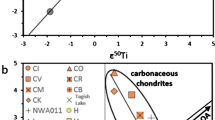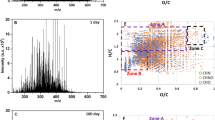Abstract
THE accretion of the Earth was characterized by high-temperature transformations of planetesimal matter during high-velocity impacts. In the final stages of the Earth's growth, up to 30% of planetesimal mass and the corresponding mass of the target were evaporated1-3. Here we look at the effect of laser-pulse heating on meteorite materials and silicates in order to simulate the vaporization which occurs during impacts and to study the chemical composition of the gases produced. In our experiments, the residual gas mixture consisted of both oxidized and reduced components: CO, CO2, SO2, H2O, H2, N2, H2S, COS, CS2, various hydrocarbons from C1 to C6, HCN and CH3CHO. In addition, we find that the composition of the gas mixtures is qualitatively similar for all samples. Our data give an idea of the chemical composition of gases that may have been released into the Earth's early atmosphere by impact devolatilization. In the gas mixtures produced by these experiments we measured weight per cents of ∼10−3 for HCN, ∼10−4 for CH3CHO and ∼10−2 for hydrocarbons. Impact vaporization is no less effective for the formation of HCN than is the formation of HCN by impact reprocessing of the atmosphere4. For the production of aldehyde and hydrocarbons, impact vaporization is even more effective. The gas mixtures formed by vaporization of silicates provide favourable conditions for abiotic synthesis of organic compounds.
Similar content being viewed by others
References
Rehfuss, D. E. J. geophys. Res. 77, 6303–6315 (1972).
Gerasimov, M. V. Pis'ma astr. J. 5, 251–256 (1979) (in Russian).
O'Keefe, J. D. & Ahrens, T. J. Proc. Lunar Sci. Conf. 8th, 3357–3374 (1977).
Fegley, B. Jr, Prinn, R. G., Hartman, H. & Watkins, G. H. Nature 319, 305–308 (1986).
Florensky, K. P. Geokhimiya 8, 909–917 (1965) (in Russian).
Lange, M. A. & Ahrens, T. J. Icarus 51, 96–120 (1982).
Gerasimov, M. V., Mukhin, L. M., Dikov, Yu. P. & Rekharsky, V. I. Vest. USSR Acad. Sci. 9, 10–25 (1985) (in Russian).
Anisimov, S. I., Imas, Ya. I., Romanov, G. S. & Khodyko, Yu. V. The Action of High-Power Laser Beams on Metals (Nauka, Moscow, 1970) (in Russian).
Gerasimov, M. V. Lunar planet. Sci. 18, 320–321 (1987).
Gerasimov, M. V., Satovsky, B. L. & Mukhin, L. M. Lunar planet. Sci. 18, 322–323 (1987).
Barsukova, L. D., Kharitonova, V. Ya. & Bannykh, L. N. Meteoritika 41, 41–43 (1982) (in Russian).
Ahrens, L. H., Willis, J. P. & Erlank, A. J. Meteoritics 8, 133–139 (1973).
Gibson, E. K., Moore, C. B. & Lewis, C. F. Geochim. cosmochim. Acta 35, 599–604 (1971).
Author information
Authors and Affiliations
Rights and permissions
About this article
Cite this article
Mukhin, L., Gerasimov, M. & Safonova, E. Origin of precursors of organic molecules during evaporation of meteorites and mafic terrestrial rocks. Nature 340, 46–48 (1989). https://doi.org/10.1038/340046a0
Received:
Accepted:
Issue Date:
DOI: https://doi.org/10.1038/340046a0
- Springer Nature Limited
This article is cited by
-
Geoscience for Understanding Habitability in the Solar System and Beyond
Space Science Reviews (2019)
-
Meteorite Impact-Induced Rapid NH3 Production on Early Earth: Ab Initio Molecular Dynamics Simulation
Scientific Reports (2016)
-
Hydrogen Cyanide Production due to Mid-Size Impacts in a Redox-Neutral N2-Rich Atmosphere
Origins of Life and Evolution of Biospheres (2013)
-
Selective Stabilization of Ribose by Borate
Origins of Life and Evolution of Biospheres (2013)
-
Prebiotic Chemistry: What We Know, What We Don't
Evolution: Education and Outreach (2012)





